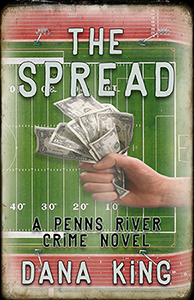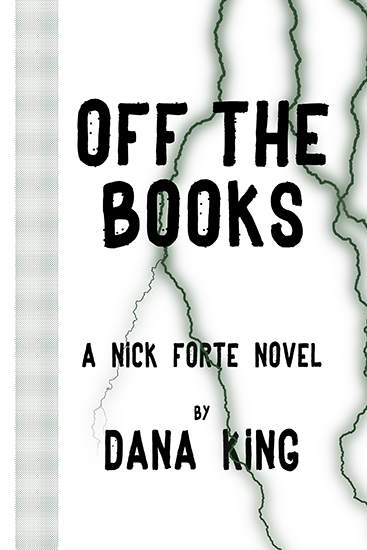Eryk Pruitt is
someone I’m proud to know. Writer, filmmaker, bar owner, and raconteur, theirs
is always something going on with him that’s worth knowing about, which means
it’s worth talking about. Eryk’s newest book, Something Bad Wrong, drops this month from Thomas and
Mercer. I was lucky to score an advance copy and I can say with confidence
that, much as I enjoyed his previous work, he’s taken a step to the next level
here. I could go on for a while about this book, but it’s always best to let
the writer do it, and no one can explain Eryk’s thought processes better than
Eryk.
One Bite at a
Time: Welcome back to the blog. It’s been a while. Tell the readers a little
about the story in Something Bad Wrong. Great title, by the way. (We’ll get
to the background behind the book in a minute.)
Eryk Pruitt: Something
Bad Wrong is the story of Jess Keeler, a woman who once aspired to be a
journalist until life gets in the way. Then, after the COVID pandemic, while
reevaluating her career choices, she stumbles upon her grandfather’s notebook
and discovers he was once a legendary local lawman who was haunted by his
inability to solve a sensational crime. In attempting to finish what she
started, she uncovers a trove of family secrets that threaten to tear their
community apart.
OBAAT: I’m a
huge fan of your podcast, “The Long Dance.” How much of what you learned from
that investigation found its way into Something Bad Wrong?
EP: Thank you
very much, Dana. I think the biggest effect that producing the podcast had on
my fiction was my access to real police work. Previously to that experience, my
fiction had primarily focused on the exploits of criminals, because criminals
were all that I had been exposed to. After working on “The Long Dance” for two
and a half years next to (retired) Major Tim Horne of the Orange County
Sheriff’s Office (NC) I learned not only how investigators work a case, but
also how investigators balance real life scenarios. Tim sent me to DNA
collection classes, allowed me to process a (manufactured) crime scene, and
enrolled me in the local citizen’s academy. Because of all of this, I was able
to feel more confident writing about the other side of the law for once.
BAAT: What was
the trickiest part of working the podcast into a novel?
EP: Anyone
who’s listened to “The Long Dance” knows there are some pretty insane twists
and turns in the story. The craziest part is that we never would have included
them if they weren’t true. So when it came time to loosely adapt these events
into fiction, there were so many real life incidents that were cut from the
book because it would require too much suspension of belief for audiences to
buy it—
EVEN THOUGH THEY REALLY HAPPENED!!!
For instance,
in real life, a former ADA and a retired homicide detective were both so
obsessed with solving the real-life murders that they gained control of the law
enforcement arm of the Department of Motor Vehicles and, after equipping their
agents with Tommy guns and radio wrist watches, took over investigations of the
double homicide. The fallout turned out to be North Carolina’s own Watergate
scandal, as this law enforcement arm was also being used to spy on political
opponents when they weren’t investigating murders. Again: This was the
Department of Motor Vehicles. (this entire situation is detailed in the seventh
of eight episodes of “The Long Dance,” one we titled “Evidence and
Information.”
Obviously, for
the sake of the narrative, page count, and my own credulity, I cut stuff like
that out. But the story that is told in Something Bad Wrong is complete
fiction.
OBAAT: You’ve
earned quite a reputation as a novelist. What made you look into true crime,
and then decide to base a novel on it?
EP: I was
always fascinated by the storytelling in the podcast “Serial,” and wanted to see if there was a way
I could engage an audience in a similar way. The stories of Patricia Mann and
Jesse McBane, which were the foundation of “The Long Dance,” is a crime that,
many years ago, shocked my community. The more we researched it, the more we
felt it was a duty to try and tell the story, bring it to a wider audience, and
tell it in the right way.
To loosely
adapt that story into fiction? Well…That’s tricky. For one, it was a story that
I could not get out of my head. They say the way to get a song out of your head
is to learn the lyrics. I investigated this story and every single nuance and
detail for 2.5 years, and it’s failure to result in a prosecution was one of
the biggest heartbreaks of my entire life. I became close with the surviving
family members and the investigators who had worked this case even longer than
I had, and that heartbreak was shared. So I wanted to give a sort of ending to
the story and by writing a fictional account that was very loosely based on
fact, I was able to give a sort of ending that the real life story wasn’t able
to achieve.
But again, Something
Bad Wrong is a complete work of fiction.
OBAAT: It has
been said that fiction is the art of using lies t tell the truth. What was the
core truth, or truth, you wanted to express in Something Bad Wrong?
EP: That's a
really good question, Dana. We live in the age of Wikileaks and #TimesUp and
#MeToo, which is supposed to make it that much more difficult for people to
behave poorly without being called out. In so many of these cold cases from
decades gone by, the bad actor wasn't necessarily some master villain or evil
genius, but just some asshole whose bad deeds never got publicly exposed. The
villain in Something Bad Wrong had lived his entire life as an asshole,
terrorizing co-workers and women and innocent bystanders, but was allowed to
keep on keeping on because [spoiler redacted]. However, if someone had
documented or exposed this behavior, then perhaps the victims would still be
alive. But that's the way it was for men/women in the days gone by. They were
allowed to act up with very few, if any, repercussions.
It was fun to
juxtapose that against the present day storyline, where Dan Decker is a
character who has been called to task for his bad deeds. I am not going to try
and place his inappropriate behavior anywhere on a scale against the deeds of
the main villain, but the main difference is that Decker was called out and
"canceled" for what he did.
Have times
changed? Does transparency equal a step towards a more perfect society? Who the
hell knows, man. But there is, thankfully, a difference between what activities
people (men) were blindly allowed to get away unnoticed with in the 70s than
they are today.
OBAAT: You
manage to keep busy. Between owning and operating Yonder in Hillsborough,
setting up the almost nightly events there (including several Noir at the Bar readings
each year), reading at Noirs at Bars from New York to Dallas, and editing the
new neo-noir magazine Dark Yonder, how and when to you find time to
write?
EP: By throwing
elbows. There are a lot of things competing for that time, focus, and energy,
and I make sure to defend that time vociferously. It’s what I’ve wanted to do
since I was a little boy and sometimes it takes reminding that the whole reason
I do anything else is to do that.
OBAAT: Let’s
talk a bit about Dark Yonder, which you edit with Katy Munger. Whose
idea was that, and what did it take to get it off the ground? (Editor’s Note:
In the interests of full disclosure, the interviewer has a vested interest in
getting the word out about Dark Yonder, as he has a story in the
inaugural issue.)
EP: It was kind
of a mutual idea. I had wanted to do a quarterly through the bar, mostly
because my community of Hillsborough, NC, is such a fervent supporter of the
arts. They pack the house for our Noirs at the Bars. They tip very well
to musicians. They buy the art off our walls. So I wanted to give back to the
writing world by bringing them to some new and passionate patrons, as well as
provide my friends at the bar with some highly entertaining stories.
Katy Munger,
the former Piedmont Laureate and author of “Tart Noir,” runs her own Thalia
Press with Lise MacClendon, and she is a regular reader at our Noir at the Bar.
She wanted to team up and do something and pitched a couple of ideas. We ended
up merging our two ideas and found ourselves very lucky to have been able to
marry our two skill sets and passions.
For our first
issue, we selected ten stories out of 250 submissions. We are very fortunate to
have the same result for #2, which will be published on April 13.
OBAAT: This
post will drop on St. Patrick’s Day. As you and your lovely wife, Lana Pierce,
went to Ireland last fall, what stuck with you most about the trip, both
personally and from a writing perspective?
EP: It was
great to get away. I had once tried to live in Ireland after college and
experienced that country alone as a penniless ex-pat. It was nice to go back
with a bit more of a budget and with the wife. Some of the biggest takeaways
cast our own country in a darker light, and I spent a lot of my focus studying
their War for Independence as well as their Civil War. Irish history is so
fascinating to me and how they overcame centuries of oppressive religious rule,
only to be thrust back into conflict with each other, is a huge lesson that I
doubt our country can learn by example. We’ll see…
OBAAT: What’s
the current writing project?
EP: My awesome
publishers at Thomas & Mercer have contracted me for a follow up book to Something
Bad Wrong which they intend to be published in the Spring of 2024 which
means I need to get back to work now.
Thank you,
Dana! It’s always great talking to you!!


